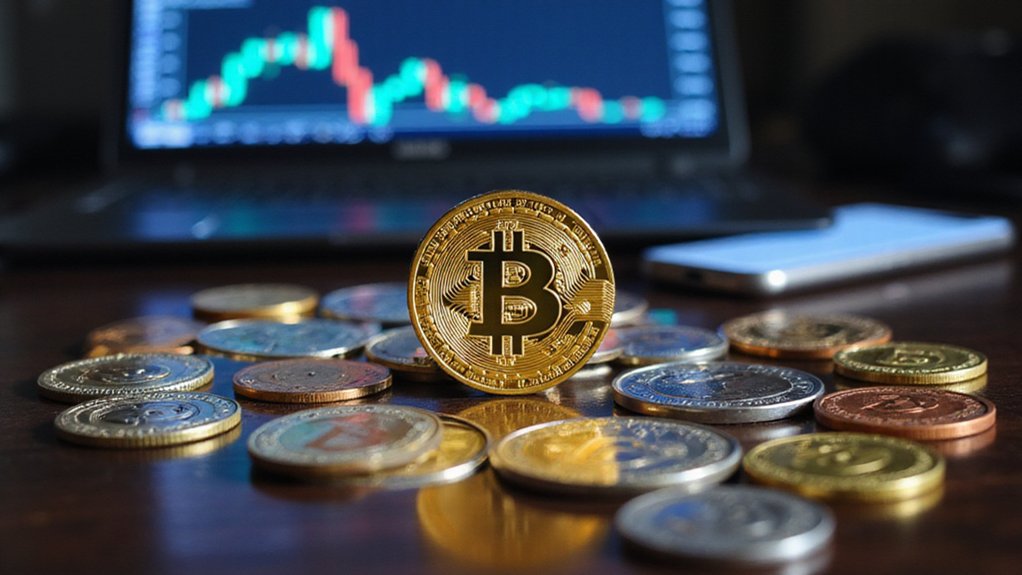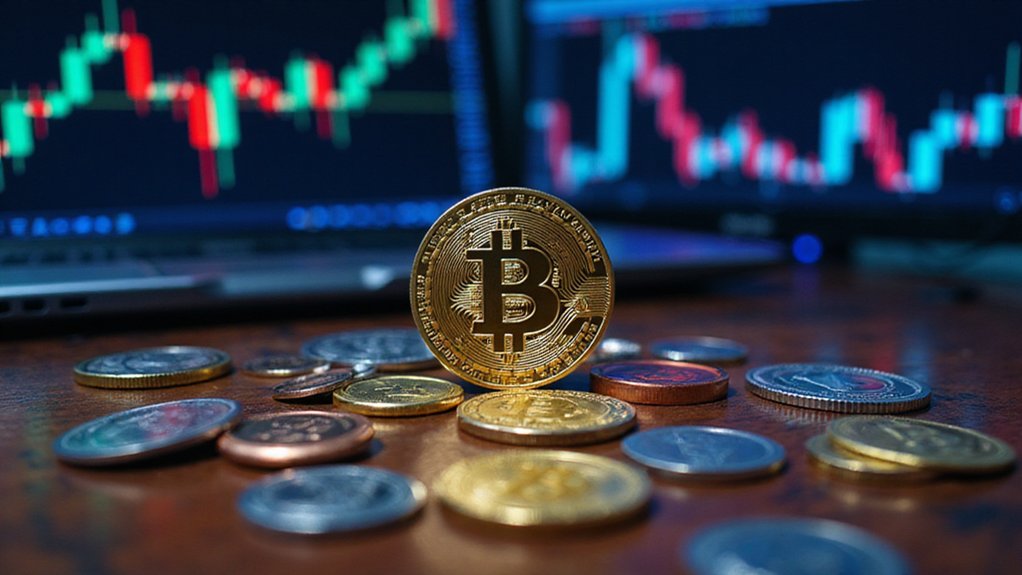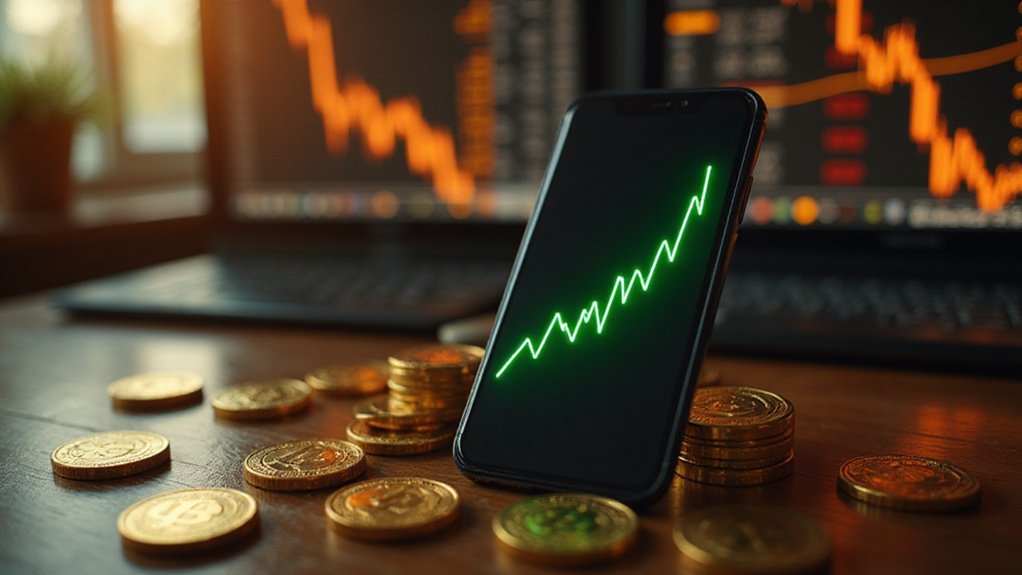Altcoin trading involves purchasing alternative cryptocurrencies beyond Bitcoin through established exchanges like Coinbase or Binance, where traders navigate thousands of options ranging from large-cap platform coins like Ethereum to speculative meme tokens. Success requires understanding market segmentation—distinguishing between billion-dollar projects offering liquidity and small-cap alternatives presenting high-risk propositions. Due diligence becomes essential given the prevalence of fraudulent projects with fabricated teams, while portfolio diversification strategies attempt to mitigate concentration risk, though this assumption proves historically optimistic during market downturns when correlations spike unexpectedly, revealing deeper complexities beneath surface-level mechanics.

The cryptocurrency landscape has evolved considerably since Bitcoin‘s solitary reign, spawning thousands of alternative digital assets—collectively termed “altcoins”.
That promise everything from revolutionary smart contract capabilities to enhanced privacy features, though whether they deliver on such lofty ambitions remains a question worth several billion dollars in collective market capitalization.
These digital alternatives distinguish themselves from Bitcoin through various technological innovations, often employing Proof of Stake consensus mechanisms rather than Bitcoin’s energy-intensive Proof of Work model.
While Bitcoin maintains its dominance through sheer market capitalization and widespread adoption as digital gold, altcoins carve out specialized niches—platform coins like Ethereum facilitating smart contracts, privacy coins like Monero obscuring transaction details, and an amusing parade of meme coins that somehow command serious investment dollars.
Bitcoin may wear the crown, but altcoins rule their respective kingdoms—some legitimate, others laughably speculative, all surprisingly lucrative.
Market segmentation provides a rudimentary risk assessment framework: large-cap altcoins (exceeding $1 billion market capitalization) generally offer greater liquidity and stability, while small-cap alternatives present the classic high-risk, high-reward proposition that has bankrupted and enriched countless traders with equal efficiency.
The diversity spans utility tokens, stablecoins pegged to traditional currencies, and sector-specific projects targeting everything from decentralized finance to supply chain management. These stablecoins differ fundamentally from other cryptocurrencies by maintaining price stability through various mechanisms including currency pegs and algorithmic controls.
Trading these assets requires using established exchanges like Coinbase, Binance, and Kraken, each offering different coin selections and fee structures.
Security considerations become paramount given the proliferation of fraudulent projects featuring fabricated teams and unrealistic technological promises—a phenomenon that would be laughable if not for the genuine financial losses involved. Understanding cryptocurrency basics becomes essential before attempting to evaluate these complex projects and their technological claims.
The volatility inherent in altcoin trading creates opportunities for substantial returns alongside equally impressive losses. When executing trades in fast-moving markets, execution prices may differ from expected levels due to the rapid price movements characteristic of these digital assets.
Lower liquidity in smaller-cap assets can trigger significant slippage, while the general lack of regulatory oversight means traders operate in a financial Wild West where due diligence becomes survival skill.
Portfolio diversification through altcoins theoretically reduces concentration risk beyond Bitcoin, though this strategy assumes these alternative assets won’t simultaneously collapse during market downturns—an assumption that history suggests may be overly optimistic.
Understanding each project’s underlying technology, use case, and market positioning becomes essential, transforming altcoin trading from speculation into informed risk assessment, though the distinction often remains frustratingly thin.
Frequently Asked Questions
What Percentage of My Portfolio Should I Allocate to Altcoin Trading?
Portfolio allocation to altcoins should remain modest—typically 5-10% of total investable assets for risk-tolerant investors, with conservative portfolios limiting exposure to 1-3%.
This positioning acknowledges altcoins’ notorious volatility while capturing potential upside.
Seasoned investors often subdivide this allocation: 60% to established mid-caps like Chainlink, 40% to speculative positions.
The key lies in treating altcoin exposure as venture capital—money one can afford to lose entirely without disrupting broader financial objectives.
How Do I Identify Which Altcoins Have the Highest Growth Potential?
Identifying high-growth altcoins requires evaluating fundamental metrics: team credibility, technological innovation addressing real problems, and genuine adoption patterns.
Smart money monitors GitHub activity, partnership announcements, and institutional interest while tracking market indicators like Bitcoin dominance shifts and volume surges.
Focus on sectors driving 2025 growth—AI integration, Web3 infrastructure, and DeFi expansion.
The irony? Most “revolutionary” projects solve problems nobody actually has.
Should I Use Stop-Loss Orders When Trading Volatile Altcoins?
Stop-loss orders prove essential for volatile altcoin trading, automatically limiting downside exposure when prices inevitably crater.
While they protect capital and eliminate emotional decision-making, traders must navigate slippage risks and premature triggering during market volatility.
Strategic placement using technical indicators—rather than arbitrary levels—optimizes effectiveness.
Trailing stops can capture upside while maintaining protection, though execution prices may disappoint during rapid selloffs when liquidity evaporates faster than rational explanations for price movements.
What Are the Tax Implications of Frequent Altcoin Trading?
*Previously discussed risk management tools become tax complications.
How Do I Avoid Falling Victim to Altcoin Pump and Dump Schemes?
Investors can sidestep pump and dump schemes by conducting thorough fundamental analysis before entering positions, particularly scrutinizing low-cap altcoins that scammers favor for their manipulability.
Red flags include coordinated social media campaigns, celebrity endorsements lacking substance, and artificial urgency tactics designed to exploit FOMO.
Smart traders prioritize data over emotion, diversify holdings strategically, and remain skeptical of parabolic price movements unsupported by legitimate technological developments or adoption metrics.









